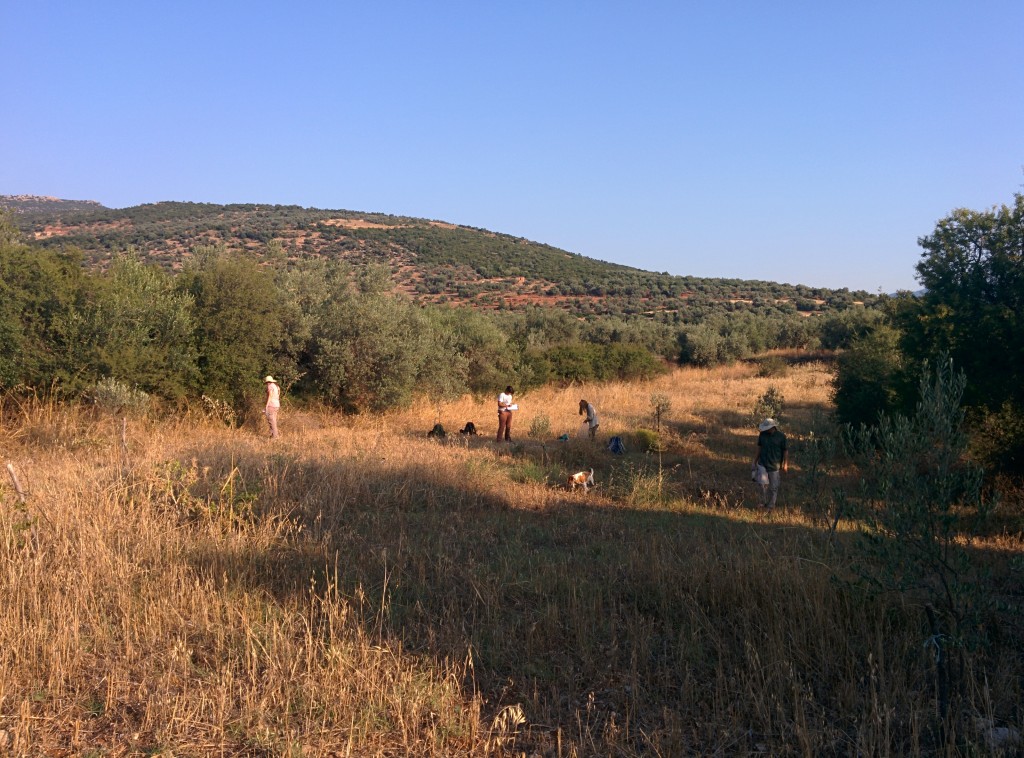All archaeological work is constrained: by budget, by personnel, by university structures, by local administrative structures, and so on. Our project is no different. Bill, Sarah and I worked on a project — the Eastern Korinthia Archaeological Survey (EKAS) — where we were limited in our ability to collect artifacts. What this meant was that survey teams would collect artifacts and then leave them in the field. Artifact processing teams would then analyze these artifacts, usually under a shady tree. As you might imagine, this wasn’t what EKAS had in mind when the permit request was written, but the project managed to find some positives from this restriction. As we wrote back in 2006,
An unexpectedly positive response to the restriction on nonsite collections was found in the creation of in-field artifact-processing teams that examined the finds in their contexts of discovery. In-field processing became a fundamental component of our integrative philosophy, and serendipitously enforced our inclination to limit artifact collections for other reasons: the negative impact on the surface archaeological record and the crisis of storage space in Greek museums.
Having ceramicists out in the field isn’t normal for most field surveys. Instead, ceramic analysts are usually to be found in the lab, processing and analyzing material that field teams have collected. This is the way that WARP works, or at least, is meant to work: Scott and Sarah stay in our laboratory and read pottery during the day.
The reason that we do this, in part, is because of limitations placed on us: our laboratory is secured by the guards of the local museum, and they hold the keys and they know the security codes. (The material in our lab is, after all, their responsibility as guards). So they open the laboratory for us in the morning, and they shut it in the afternoon. That means that our lab time is limited to 8 am to 2 pm at best, as we work around the regular working hours of the museum guards. Our field time is also limited by these hours: we need to return from the field by 2 pm, so that the artifacts we collect can be placed in our secure labotary/storage facility. Other projects are allowed to work in the lab in the afternoon and evening, after the field-work is done, but this is a luxury that is not available to us.
So, if we’re going to keep up with the material we’re collecting (which is important for all kinds of reasons), Sarah and Scott need to be working full-time in the lab. The downside to this is that we miss their expertise in the field, and they miss out on experiencing the landscape as they would like (and as we would like them to).
But things changed on Tuesday, as our ceramicists took to the field:
What you’re seeing there is an awful lot of expertise, collecting all the good stuff — by which I mean diagnostic bits of pottery and tile. What I want to stress is that what we gain in efficiency by having Scott and Sarah in the lab we lose in in-the-field expertise. We lose what EKAS had: all of its experts in the field at once. Indeed, having Scott and Sarah in the field on Tuesday was incredibly useful, as they were able to pick up material that gave us a lot more chronological and functional information about the areas that are of particular interest to us. It’s also incredibly useful for the project to have our experts out in the field because invariably the more sets of knowledgeable eyes we have on our survey area, the better our interpretations will be. Sarah will look at the landscape differently than I, but the best interpretations will take account of both of our impressions and understandings.
Perhaps this is yet another example of the trade-offs between efficiency and expertise. It is efficient, given the restrictions under which we work, for me and Bill to work in the field and for Sarah and Scott to work in the lab — mostly because Bill and I would make a hash of our survey pottery — but this really limits the very thing that fieldwork needs most to produce good knowledge: expertise at the edge of archaeological discovery.
